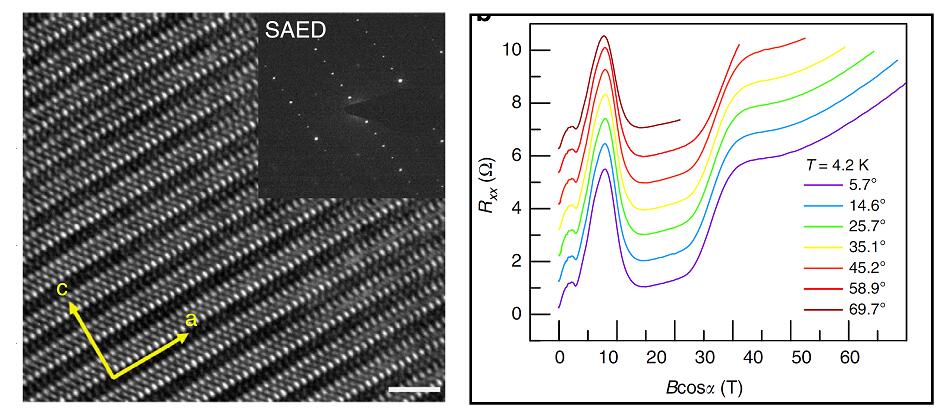
An HRTEM image of ZrTe5with an inset selected area electron diffraction (SAED) pattern and angular-dependent MR as a function of effective magnetic field perpendicular to a–c plane
(Nature Communications 12 Aug 2016. DOI: 10.1038/ncomms12516)
Background
In the past few decades, transition-metal pentatelluride ZrTe5has attracted considerable attentions for its mysterious temperature anomaly. Charge density wave was believed to be the origin of the anomalous peak in the temperature dependent resistance but later it was excluded by experiments. At the same time, both theory and experiments demonstrated that the band structure of ZrTe5is very complicated with multiple bands contributing to the electronic properties. Both singlefrequency and multi-frequency Shubnikov–de Haas (SdH) oscillations were reported in ZrTe5, suggesting a strong dependency of the electron states on the Fermi energy in the band structure.
What we discover?
Recently, the research group of Faxian Xiu in the department of physics at Fudan University has firstly observed a novel field-induced spin density wave state in studying the electrical transport properties of Dirac semimetal ZrTe5under high magnetic field, which offers a new perspective and ideas for the research of Dirac semimetals. The related article titled “Zeeman splitting and dynamical mass generation in Dirac semimetal ZrTe5”was published in the internationally authoritative journal-Nature Communications in August 12th.
Why is this important?
In recent years, Dirac semimetal has attracted considerable attentions. Dirac semimetal has similar band structure with graphite, which provides a good platform for researchers to do basic physics research and has broad application prospect due to its excellent electrical properties such as large magne to resistance and high electron mobility. Recently, a large number of theoretical studies have pointed out, the many-body correlation effects could induce novel phase transitions in Dirac semimetals and a Dirac mass is spontaneously generated by interaction effects, which had not been verified by experimental reports.
Why did they need the MagLab?
In this work, the research group of Faxian Xiu has studied the magne to transport properties of Dirac semimetal ZrTe5under pulsed high magnetic field. The research has unveiled good quasi-2D nature of ZrTe5behaving body-state quantum Hall effect. Meanwhile, the Zeeman splitting could be easily observed and this material can be driven into its quantum limit regime in a relatively weak magnetic field, leading to much more pronounced many-body correlation effects with increasing magnetic field. In an ultra-high magnetic field up to 60 T, an abnormal change of the resistance is observed in the sample, suggesting a field-induced phase transition, which is the spin density wave caused by the increasing many-body correlation effects after the system was driven into the quantum limit. This discovery indicates that Dirac semimetal is an ideal platform for investigating topological correlation effects, and provides a new research avenue for further studying of Dirac electronic properties.
Who did the research?
Yanwen Liu1,2,3, Xiang Yuan1,2,3, Cheng Zhang1,2,3, Zhao Jin4, Awadhesh Narayan5,6, Chen Luo7, Zhigang Chen8, Lei Yang8, Jin Zou8,9, Xing Wu7, Stefano Sanvito5, Zhengcai Xia4, Liang Li4, Zhong Wang10,11& Faxian Xiu1,2,3
Pulsed high magnetic field measurements were performed at Wuhan National High Magnetic Field Center. Prof. Xing Wu of East China Normal University and Prof. Jin Zou of University of Queensland in Australia provided the help of transmission electron microscope characterization; Theoretical support was provided by Prof. Zhong Wang of Tsinghua University and Prof. Stefano Sanvito of Trinity College, Dublin, Ireland. This work was supported by the department of Physics and State Key Laboratory of Surface Physics of Fudan University, the National Young 1000 Talent Plan and National Natural Science Foundation of China.
